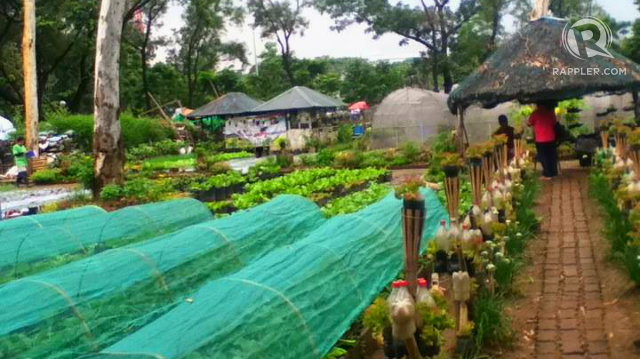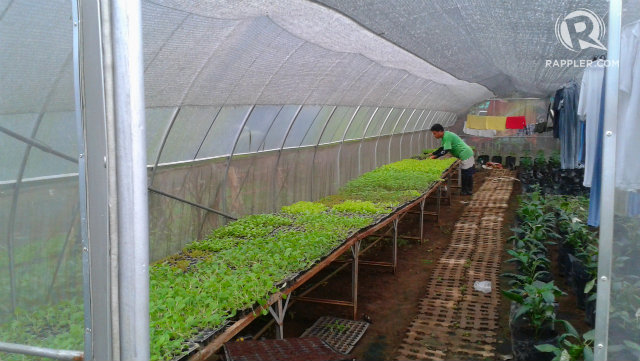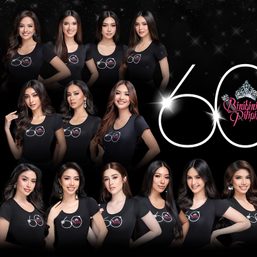SUMMARY
This is AI generated summarization, which may have errors. For context, always refer to the full article.

MANILA, Philippines – Can we farm in the city?
Unknown to many, right smack in the middle of the Quezon Memorial Circle, rows of vegetables line the 1,500-square-meter space.
This main demo farm is just one of the many sites under Quezon City’s “Joy of Urban Farming” program launched in 2010 by Vice Mayor Joy Belmonte. Until today, the program tries to spread green thumbs among city-dwellers.
From 3 pilot farms, the city now has 84 – of varying sizes – scattered across barangays, public elementary schools, daycare centers, parishes, and non-governmental organizations (NGOs).
“We’re slowly trying to make people adapt to the idea of growing their own food to partially fulfill their needs,” Belmonte said. “We’re also working with provinces like Nueva Vizcaya for farmer-to-consumer projects to help them get better income and access.”
In the future, Quezon City plans to cover all barangays and more schools, including high schools.
How it works

Quezon City’s urban farms are open to all; anyone can plant and harvest for free. Those who want to learn or experience gardening are also welcome.
Other barangays also operate “pick and pay” programs in which families help harvest and get discounts in exchange.
School gardens are maintained by students, teachers, and janitors. They not only provide vegetables for feeding programs, but also educate students on the importance of health and nutrition.
The main demo farm is visited by other local government units (LGUs) – within and outside the metro – that want to learn urban farming techniques. “Hopefully, other LGUs can follow suit,” Cristina Perez, program head, said. Quezon City was the first to launch urban farming within NCR.
Before establishing urban farms, participating barangays undergo seminars. Barangay captains must take the lead in initiating and maintaining the farms. The team behind “Joy of Urban Farming” also does ocular inspections to see if the environment is suitable for farming. The agriculturist then plans a design based on the available space.
Barangays, schools, parishes, or NGOs must provide their own land and maintenance staff. Some barangays hire street sweepers and barangay security development officers to help manage farms.
Parolees of the Regional Trial Court, as part of their rehabilitation activities, also help maintain the main demo farm.
The program provides start-up kits composed of farming tools, seedlings, fertilizers, and soil. However, it does not want to develop dependence. “This is not a dole-out program forever,” Perez said.
Each urban farm is expected to become self-funding and sustainable in the long run. To make this happen, the program has resident gardeners and agriculturists stationed in the main demo farm who oversee city-wide operations.
The program is funded by the Vice Mayor’s office.
‘Doable’
“Urban farming is not impossible,” Perez said. She clarified that farming is “doable” even in limited spaces. “Just be creative and smart about it.”
 The main demo farm, for example, is relatively small for a typical farm. It is small, but everything is in place. To save space, vegetables are also planted in recycled plastic bottles hanging over plots.
The main demo farm, for example, is relatively small for a typical farm. It is small, but everything is in place. To save space, vegetables are also planted in recycled plastic bottles hanging over plots.
Since green leafy vegetables like lettuce, mustasa, pechay, and kangkong have shallow roots, they can be planted in small containers such as recycled plates, sacks, and basins. “Kahit butas na tabo, puwede pagtaniman,” Perez added. (Even containers with holes can be used for planting.) “We can also convert garbage to fertilizers.”
Perez urges Filipinos to break the old notion that farming is only for provinces. “In fact, we get visitors from the LGUs of Isabela and Pangasinan interested in urban farming,” she added.
Quezon City also has partnerships with the Department of Natural Resources and the Department of Agriculture; the agencies provide them with financial grants.
“One of the biggest challenges in making urban farming successful is the lack of political will among barangay captains,” Perez said. “For example, one captain supports urban farming, but after his term, the next captain might not be as supportive.”
Perez praised NGOs that were able to maintain sustainable urban farms. Most of them use their farms for feeding and livelihood programs.
“The main goal is to improve nutrition, while also trying to reduce poverty,” Raul Norbe,  program agriculturist, said. The program teaches families to start farming in their own backyards – which can provide them food security or extra income.
program agriculturist, said. The program teaches families to start farming in their own backyards – which can provide them food security or extra income.
Norbe added that urban farming also promotes organic agriculture, “We don’t’ use chemical fertilizers to protect the environment and to make crops safer.” Although organic fertilizers are more expensive, Norbe advised LGUs to invest in them.
Lastly, urban farming can remind people to pause and take a break from their hectic city lives. “In gardening, you realize that everything in life is connected to the soil. You get a deeper understanding of life. You get your hands dirty to create something beautiful and useful,” Norbe said. – Rappler.com
For more information on Quezon City’s urban farming, or for those who want to avail of support from “The Joy of Urban Farming,” you may write a letter to the Office of the Vice Mayor at qc_vmjoyb@yahoo.com or call 988-4242; 921-7711.
How can we help fight hunger? Send your stories and ideas to move.ph@rappler.com. Be part of the #HungerProject.
Add a comment
How does this make you feel?





There are no comments yet. Add your comment to start the conversation.